My customer was delighted with her purchase of a glass table with a unique beveled glass base but, with a small child in the house, she was concerned that the table might be unsafe. Her worry was mainly the possibility of lead poisoning so she reached out to the experts at Artistry in Glass for advice.
From her excellent images, we figured out that the metal came was brass rather than lead and so we were able to reassure our customer that the danger of lead poisoning was very low. We further assisted her by recommending that the heavy top should be attached to the base to prevent the 1/2” thick glass from toppling over with dangerous results.
Customer’s request to Artistry in Glass
“I’m writing today after reading your article online about leaded glass toxicity. It is my hope that you would be kind enough to help me understand the risks a little better. I’m a Mom to a 9-year-old and three dogs. I found a beautiful dining table online at a local thrift store that I’ve fallen in love with. It’s being sold as ‘leaded vintage’. I wasn’t aware of the issues surrounding owning a piece of leaded furniture poses. I thought it was more of a risk during the manufacturing process, so now I’m worried about having the table delivered and possibly harming my family.”
“I’m not concerned about my daughter, 9 licking the table base but I am a little concerned that the tabletop being something we all would all touch during meals and maybe the top was also leaded glass? My main concern is that my dogs would lick the base where the glass is set into the decorative formation and they would become sick and then we would become sick after we kiss their little faces or they would lick ours. Am I overthinking this or is this a real hazard/concern and I would be wise to NOT bring this table into my home?”
“Here are pictures the table in question if you’re kind enough to shed some light on this particular situation. I’d be so grateful.”
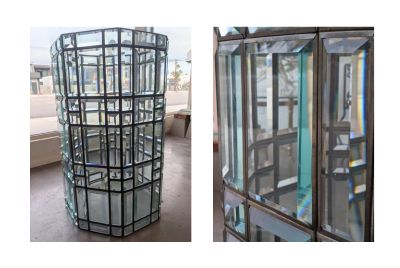
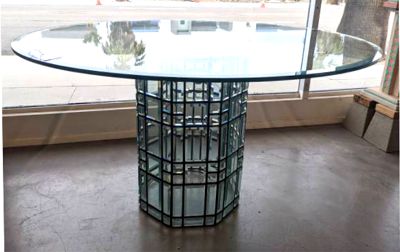
The danger of lead in the home
With over 35 years of experience in the manufacture and repair of leaded, stained, and beveled glass, Artistry in Glass is very knowledgeable in all fields of glass safety. In particular, we have written informative posts on glass tabletops, on the potential danger of leaded, stained glass in the home, and on the danger of lead crystal glassware.
According to the CDC: exposure to lead can seriously harm a child’s health and cause serious adverse effects such as:
- Damage to the brain and nervous system
- Slowed growth and development
- Learning and behavior problems
- Hearing and speech problems.
Lead in households has been especially dangerous in lead pipes (remember Flint, MI) and in lead-based paints. It is less dangerous in stained glass windows.
To summarize our conclusions: the danger of lead in stained glass is most serious for the glass fabricator who may inhale lead fumes while soldering. It is less dangerous once the stained glass is installed in the home as long as children are not able to lick the lead or ingest dust that may fall from poorly maintained leaded glass.
In view of these facts, it is highly appropriate for a conscientious parent to be concerned about the dangers of lead to their children.
Response from John Wakefield of Artistry in Glass
“First of all – you have a beautiful and unique piece of furniture that will NOT endanger your family or pets in any way. The top is made from regular 1/2” thick “plate” glass with a nice, 1″ wide, beveled edge. This tabletop glass has no lead content.” (Follow this link to learn about beveling.)
“As far as the base is concerned: you are correct that the main danger of lead toxicity occurs during manufacture when workers can inhale lead fumes from the soldering process.”
“Your beautiful base is made from beveled glass in brass came (from the photos, I am pretty sure it is brass but it is a little tarnished – am I correct?). In any case, it is not lead – so you are extra safe.”
“For maintenance, protection, and to make your table base sparkle, we recommend polishing it with a special stained glass polish like this one:”
E.J. Wheaton Co. Glass Wax, Polishes and Protects Windows, Mirrors and Metal Surfaces, Dries Chalk White, Easy to Apply and to Remove, Made in the USA
A safety concern – the top may topple over!
“One significant safety concern is that the top could possibly tilt and fall off because the overhang is large. I recommend gluing the top to the base using clear silicone. Squeeze a thin silicone bead along the center of the brass top and, with a helper, place the tabletop down onto the silicone.”
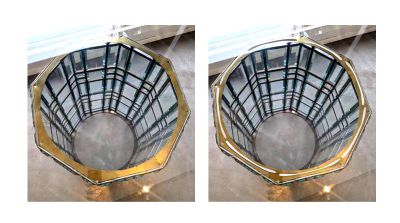
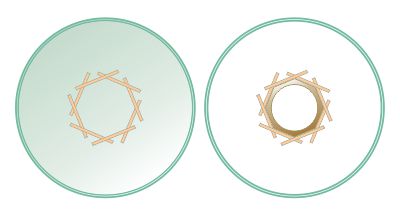
“Important tip – use masking tape on top of the glass to indicate the center and position of the top exactly. This way, with a helper, you can place the tabletop precisely in the right position so the silicone does not smear. If this is done correctly, with the use of just the right amount of clear silicone, the adhesive will be almost invisible. Leave undisturbed overnight to set up.”
A happy outcome!
Our customer used the recommended stained glass polish to produce the stunning outcome captured in the image below. We confidently expect Lady Gaga to be seen sauntering nonchalantly into this stylish Florida home!
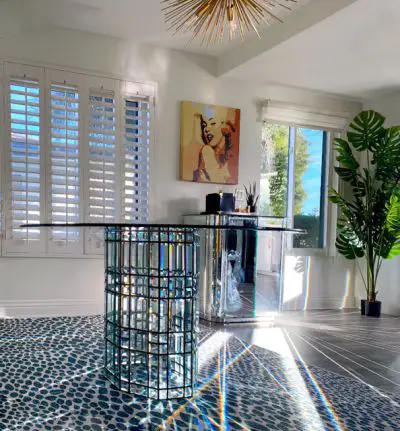
Our customer expresses her gratitude
“THANK YOU for being so kind and helpful! I appreciate it so much! Yes – it looks like aged brass so I’m am soooo happy it’s not a health hazard! “
and is good enough to give us a 5-star Google testimonial to thank us for the advice.

Glass insider tip
Learn about the came or channel used in stained glass.
What is “came” in the manufacture of stained glass?

Came is the name for the “H” or “U” shaped channel used to construct leaded glass. It comes from the Latin “Cannae” for reeds because of the original method of manufacture. Dried and whittled stacks of reeds were packed together in elongated containers and molten lead was poured on top. When the organic material burned out the remaining solidified lead is in the form of sticks with a roughly H-shaped profile.
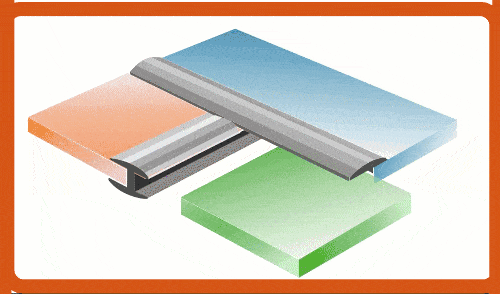
With the advent of the industrial revolution, the manufacturing of came was done by the extrusion process and alternative metals could be used. Zinc (used extensively by Frank Lloyd Wright for his Prairie-style windows), brass, or even copper became available with the advantages of being much stronger than lead.
What are the dangers of glass in the home?

Glass is a wonderful material that offers numerous practical and esthetic benefits in interior design, BUT it is essential to take great care to safeguard your family against possible harm. Remember – always consult a professional if in any doubt: broken glass can be dangerous, life-threatening, or even deadly and lead is poisonous. Artistry-in-Glass is happy to provide guidance but we cannot be held liable for any actions taken as a result of advice given on this website.
All you need to know about art glass
Commissioning stained and etched glass
- Stained glass designs from Artistry in Glass
- How to commission a stained glass window – complete advice
- How to commission an etched glass window
- How to choose the best stained glass design
- Etched or stained glass – which is better for your home?
- How much does stained glass cost?
- How much does etched glass cost?
Technical information
- Is leaded glass dangerous? Learn the facts.
- How to replace broken patio table glass
- Plexiglass and glass – what are the pros and cons?
- What is plexiglass used for?
- What costs more – glass or plexiglass?
- Preservation of stained glass in churches & synagogues
- How does stained glass get colored? learn from an expert!
- Is your broken stained glass panel worth repairing?
- How to protect stained glass in religious buildings
- How to care for and clean stained glass
- How to repair cracked stained glass
- What is Dalle de Verre?
- How to repair Dalle de Verre
- What to do about bowed & sagging stained glass
- How to care for a stained glass skylight
- Can my stained glass lampshade be repaired?
- What is the difference between sandblasting & etching?
- Obscure and frosted glass – all you need to know!
- How to save money when buying glass
- Glossary of important terms used in decorative glass
- 14 Ways to sell stained glass
- What is imitation or faux stained glass?
Guides to stained glass design
- Guide for designing abstract stained glass
- Why choose abstract contemporary stained glass
- How to design a Frank Lloyd Wright-style window
- Designing a WWII-era stained glass Waco glider
- Stained glass and Black Lives Matter
- How Is stained glass used today?
Glass tabletops & shelves – info from Artistry in Glass
- Benefits of glass shelving – info from experts!
- How much do glass tabletops cost?
- Do glass shelves need to be tempered?
- What is the best thickness for glass shelves?
- Best edge type for glass shelves, polished or beveled?
- How much weight can a wall shelf carry?
- What color glass should my shelves be?
- Glass tabletops – 10 amazing benefits explained
- How to order a glass tabletop
- Best thickness for glass tabletops – expert advice
- Should glass tabletops be tempered?
- Should glass tabletops be beveled?
- How to paint a glass tabletop
- All about tempering glass tabletops!
- How to tell if your glass is tempered
- Can tempered glass be cut?
- How to protect your wood table with glass
- How to fix a scratched glass tabletop
- How to fix a chipped glass tabletop
- How to replace broken patio table glass
- How to measure for a glass tabletop
- Video – how to measure your tabletop
- Plexiglass vs glass – pros and cons
- Beveled glass table base – a case study
- Choosing between tempered & laminated glass
- Glossary of terms used in the glass business
Unique Mirror Resources from Artistry in Glass
Mirror Design & layout
- How are mirrors made?
- What is a beveled mirror?
- What is a two-way mirror?
- Best mirrors for bedrooms
- How to size and position your wall mirror
- How to order custom etched mirrors
- Best places to hang dining room mirrors
- How much do wall mirrors cost?
- Shop the MIRROR Family Package
Mirror Installation & Removal
- How to hang a wall mirror
- How to frame a builder’s grade bathroom mirror
- How to hang a frameless mirror with glue
- Best clips for hanging mirrors
- How to attach a mirror to a closet door
- How to remove a mirror glued to the wall
Mirror Repair & Restoration
- Should I resilver my antique mirror?
- Can I repair scratched mirror silvering?
- What is the best spray paint for mirror silvering?
- How to fix a cracked mirror
- How to repair a broken mirror frame
Artistry in Glass was your source for antique repair in Tucson
Check out this amazing selection of informative articles:-
- Where can I get antiques repaired?
- Are broken antiques worth fixing?
- How to fix a broken picture frame
- How to repair a broken china plate
- How to repair a broken china teapot
- How to fix a broken marble slab
- How to repair a broken china coffee mug
- How to repair a 2000-year-old sculpture
- All about repairing stained-glass lampshades
- How to care for your stained glass skylight
- How to repair Dalle de Verre
- Is stained glass worth repairing?
- To repair or toss out?
- Tucson crystal & china repair a division of Artistry in Glass
- What to do with broken antiques
- Is lead crystal dangerous?
- Repairing an antique Mexican statue
- Repairing religious statues
- The history of Swarovski crystal figurines
- How to find the value of a Swarovski Crystal figurine
- Have Swarovski crystal figurines lost value since 2009?
- How to collect Swarovski annual ornaments
- How to display Swarovski crystal figurines
- How to authenticate a Swarovski crystal figurine
- How to display Swarovski annual ornaments
- How to clean Swarovski crystal figurines
- How to repair a Swarovski crystal mouse
- How to repair a Swarovski annual ornament
- How to repair a Swarovski crystal train set
- Fixing broken wine glass stems
- How to clean cloudy glasses
- Why do wine glasses have stems?
- Swarovski Crystal Figurines
- How to repair a chip in a wine glass
- How to fix a scratched glass tabletop
- How to replace a broken patio tabletop


